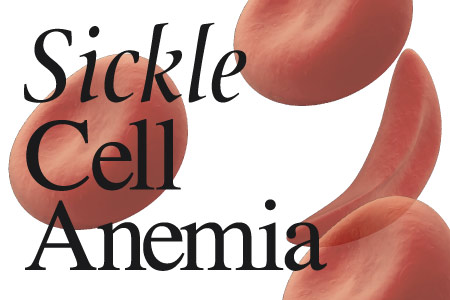Sickle Cell Anemia Causes, Symptoms, Diagnosis and Treatment

What Is Sickle Cell Anemia?
Sickle cell anemia is a hereditary blood disorder, caused by an abnormality in the oxygen-carrying protein haemoglobin found in red blood cells.
This leads to a propensity for the cells to assume an abnormal, rigid, sickle-like shape under certain circumstances.
Sickle-cell disease is associated with a number of acute and chronic health problems, such as severe infections, attacks of severe pain (“sickle-cell crisis”), stroke, and an increased risk of death.
Almost 300,000 children are born with a form of sickle-cell disease every year, mostly in sub-Saharan Africa but also in other parts of the world such as the West Indies and in people of African origin elsewhere in the world.
There’s no cure for most people with sickle cell anemia. However, treatments can relieve pain and help prevent further problems associated with sickle cell anemia.
Causes Of Sickle Cell Anemia:
Sickle cell anemia is caused by a mutation in the gene which controls the production of hemoglobin (the red, iron-rich compound that gives blood its red color).
Hemoglobin allows red blood cells to carry oxygen from lungs to all parts of the body.
In sickle cell anemia, the abnormal hemoglobin causes red blood cells to become rigid, sticky and misshapen.
The sickle cell gene is passed from generation to generation in a pattern of inheritance called autosomal recessive inheritance. This means that both the mother and the father must pass on the defective form of the gene for a child to be affected.
If only one parent passes the sickle cell gene to the child, that child will have the sickle cell trait. With one normal hemoglobin gene and one defective form of the gene, people with the sickle cell trait make both normal hemoglobin and sickle cell hemoglobin.
Their blood may contain some sickle cells, but they generally don’t experience symptoms. However, they are carriers of the disease, which means they can pass the defective gene on to their children.
Symptoms Of Sickle Cell Anemia:
The following symptoms are exhibited:
- Anemia.
Fatigue due to lack of oxygen transported to the body. - Episodes of pain.
Also called “Crises”
The pain may vary in intensity and can last for a few hours to a few weeks. - Hand-foot syndrome.
Swollen hands and feet. - Frequent infections.
Sickle cell anemia can lead to damaged spleen - Delayed growth.
A shortage of healthy red blood cells can slow growth in infants and children and delay puberty in teenagers. - Vision problems.
Diagnosis Of Sickle Cell Anemia:
The following tests and exams may help confirm the diagnosis:
- Blood test, to check for haemoglobin S
- haemoglobin electrophoresis
- Testing a sample of amniotic fluid for unborn babies
Treatment Of Sickle Cell Anemia:
The following treatment options are available:
- Medications
Antibiotics
Pain relieving medications
Hydroxyurea (Droxia, Hydrea) - Blood transfusions
- Supplemental oxygen
- Stem cell transplant
By : Natural Health News




